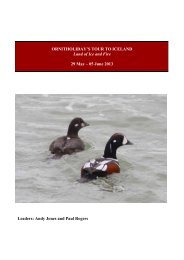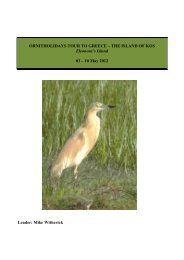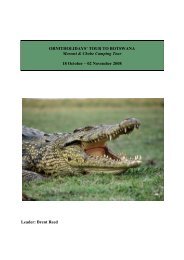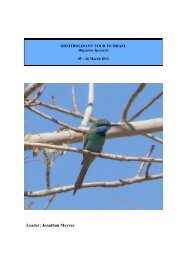Download 2014 Brochure (.pdf) - Ornitholidays
Download 2014 Brochure (.pdf) - Ornitholidays
Download 2014 Brochure (.pdf) - Ornitholidays
Create successful ePaper yourself
Turn your PDF publications into a flip-book with our unique Google optimized e-Paper software.
E GY P T<br />
Egypt<br />
Birds & History<br />
Friday 24 October – Tuesday 04 November <strong>2014</strong><br />
Leaders: Mike Witherick and local guides<br />
<strong>2014</strong> Cost: £3,299 single room supplement £390<br />
EGYPT<br />
Cairo<br />
Giza<br />
Luxor<br />
Aswan<br />
Lake Nasser<br />
Abu Simbel<br />
ur “Land of the Pharaohs” tour has been designed with just the right combination of bird watching<br />
O and sightseeing. We will visit all the key habitats to find birds of the deserts, wetlands and marine and coastal environments. Given Egypt’s strategic<br />
location, it is one of the best places to see a number of species found nowhere else in the Western Palearctic, such as Senegal Thick-knee, Nile Valley<br />
Sunbird, Senegal Coucal and perhaps Kittlitz’s Plover. We will watch birds while exploring Egypt’s world famous antiquities, which have inspired and<br />
awed man through the ages. The Ancient Egyptians were among the world’s first natural historians and vividly documented the wildlife of their times on<br />
the walls of tombs and temples. No other country allows us the opportunity to bird watch in the past, as over 75 species of birds have been identified<br />
from the wall paintings and countless other artefacts. The life of Egypt will be well observed – from the modern skyscrapers of Cairo to the lowly mudwalled<br />
villages of the Nile. We will spend four nights on a Nile cruise, the ideal way to sightsee and bird watch Upper Egypt, as at this time of year the<br />
Nile will be teeming with wintering waterbirds and the weather should be superb. This will be <strong>Ornitholidays</strong>’ 12th tour to Egypt.<br />
Great Pyramid and Sphinx<br />
ITINERARY<br />
Days 1 & 2<br />
We fly from London on a scheduled flight to<br />
Cairo. Upon arrival we transfer to our hotel in<br />
Giza near the pyramids, where we stay for two<br />
nights. Next morning we drive into town where<br />
we see our first Nile Valley birds, such as<br />
Eurasian Hoopoe, Common Bulbul, Palm Dove,<br />
Yellow-billed Kite and Ring-necked Parakeet. We<br />
take a guided tour of the Egyptian Museum<br />
where we will see the fabulous treasures of<br />
Tutankhamun and the Geese of Medium, a<br />
masterpiece of ancient Egyptian bird art. We<br />
then drive south along the Nile Valley to<br />
Saqqara, the cemetery of Memphis, located on<br />
the desert fringe, where we will see the Steppe<br />
Pyramid, considered the first successful attempt<br />
at pyramid building. We then visit the tombs of<br />
Saqqara with their wonderful scenes of every<br />
day life and depictions of Egyptian wildlife.<br />
Day 3<br />
We drive south through the Western Desert to<br />
Lake Qarun in the El Fayoum Oasis. This<br />
picturesque lake is home to Slender-billed Gull<br />
and the surrounding reed beds are one of the<br />
best sites to see Clamorous Reed Warbler and<br />
Little Bittern. Wintering waterbirds that frequent<br />
the lake include Great Black-headed Gull as a<br />
regular visitor and Marsh Sandpiper, Jack Snipe<br />
and Temminck’s Stint are just some of the<br />
waders that can be found around the shores. In<br />
the surrounding farmlands we see<br />
characteristic agricultural species, such as<br />
Cattle Egret, Crested Lark, Spur-winged<br />
Lapwing and Graceful Warbler. In the afternoon<br />
we visit the pyramids and Sphinx, one of the<br />
wonders of the ancient world. Here, we see the<br />
Solar Boat, a completely preserved mortuary<br />
boat, unearthed next to the Great Pyramid and<br />
restored to its former grandeur. We return to<br />
Cairo and spend the night at our hotel.<br />
Day 4<br />
An early morning flight takes us to Abu Simbel<br />
on the shores of Lake Nasser, a huge reservoir<br />
formed after the construction of the Aswan High<br />
Dam. We spend the morning birding in the hotel<br />
gardens and the lakeshores, looking for African<br />
specialities, such as Egyptian Goose, Kittlitz’s<br />
Plover and African Pied Wagtail. Interesting<br />
winter visitors can be found in the surrounding<br />
deserts such as Desert and Pied Wheatears.<br />
Given Abu Simbel’s strategic location near the<br />
border with Sudan, it is one of the best sites to<br />
find a Western Palearctic rarity. After lunch at the<br />
hotel we will visit Abu Simbel Temple, built in<br />
honour of Ramses II and his beautiful wife,<br />
Nefertari. This magnificent construction is<br />
amazing, not only for the structure itself, but for<br />
the fact that the temple was taken apart block by<br />
block and moved to higher ground to save it<br />
from the rising waters resulting from the dam.<br />
Afterwards we return to the hotel for some<br />
optional birding until dusk. In the evening we will<br />
60<br />
For a previous tour report or further information please call: 01794 519445








